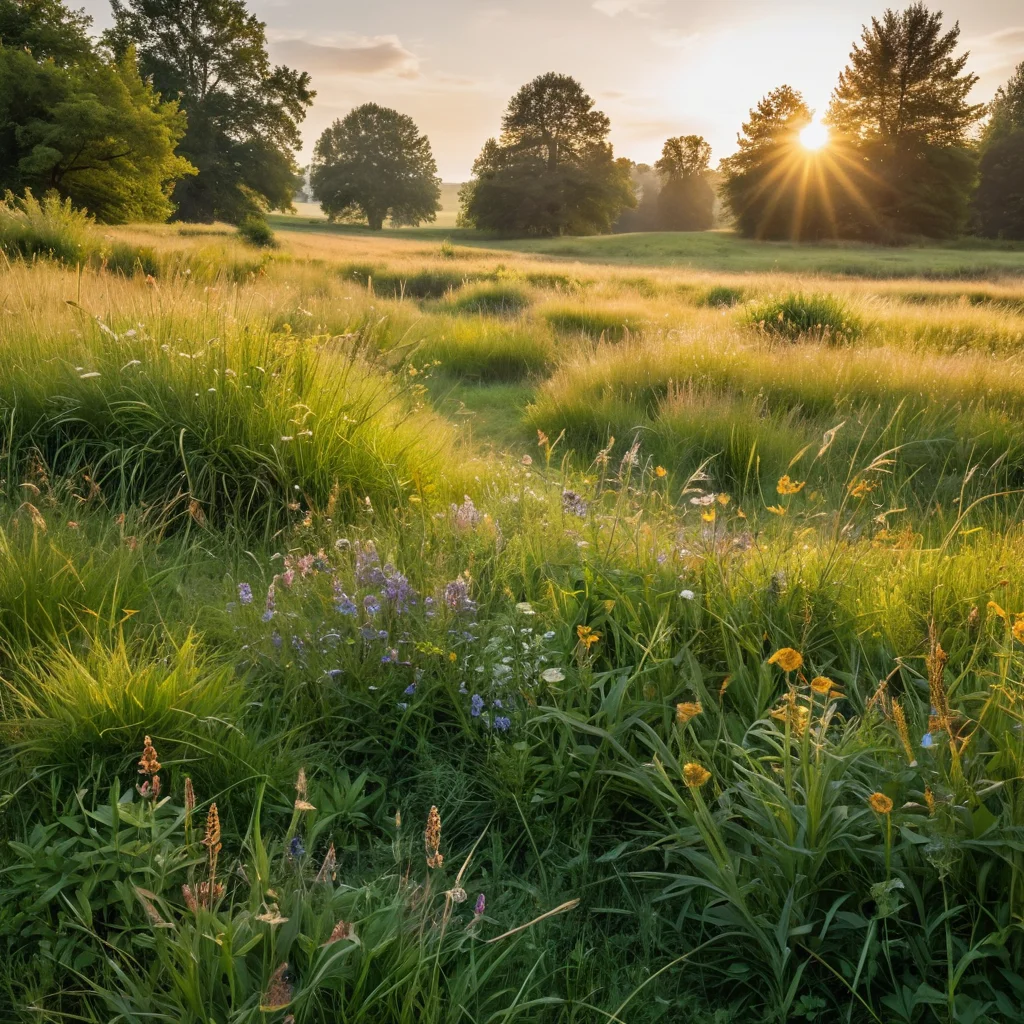The smell of damp earth after a summer rain, the quiet rustle of grasses in the wind, the ringing buzz of bees diligently flitting among wildflowers… Isn’t this what the soul dreams of, tired of the city bustle? Your plot is not just land; it’s a canvas on which you can paint your personal picture of harmony and tranquility. And a meadow lawn, this piece of wild nature, tamed and beautified by your hands, will become one of the brightest colors on this canvas. I’ve always loved this feeling – walking barefoot on soft, slightly damp grass, feeling its resilience and coolness. It’s not just a lawn; it’s a whole ecosystem that breathes, lives, and delights the eye with its natural beauty. It requires less effort than its “cultivated” counterparts but offers much more emotion and a sense of genuine connection with nature. Let’s create this corner of living wonder at your dacha together!
What is a Meadow Lawn and Why is it Ideal for Your Plot?
When we say “meadow lawn,” imagine something truly special. It’s not the perfectly mowed, uniform green carpet we’re used to seeing in glossy magazines. A meadow lawn is essentially a mini-ecosystem that recreates the beauty of natural meadows and fields. It consists of various grasses, cereals, and, most importantly, wildflowers. This makes it not only beautiful but also incredibly alive, attracting pollinating insects, birds, and butterflies. Imagine butterflies fluttering over your plot, bees collecting nectar from delicate bluebells and daisies… It’s not just a lawn; it’s a true living corner of nature right outside your windows!
Why is it ideal for your dacha? Firstly, low maintenance. Meadow grasses are generally more resistant to drought, diseases, and pests than lawn mixes. They tolerate different soils well and don’t require as frequent and complex care as a regular lawn. Secondly, aesthetics. Natural beauty, a variety of shapes and colors, constant change depending on the season – all this makes a meadow lawn unique and captivating. It harmoniously fits into any landscape style, especially natural, rustic, or picturesque. Thirdly, eco-friendliness. Such a lawn doesn’t need aggressive fertilizers or chemicals; it creates a healthy environment for life and relaxation. It contributes to preserving biodiversity on your plot.
Key characteristics of a meadow lawn:
- Biodiversity: a mix of cereal grasses, legumes, and flowering plants.
- Natural appearance: a variety of shades of green, presence of inflorescences.
- Low maintenance requirements: less frequent mowing, minimal use of fertilizers.
- Resilience: to drought, diseases, pests, and temperature fluctuations.
- Eco-friendliness: support for local fauna, absence of chemicals.
By creating a meadow lawn, you’re not just decorating your plot; you’re creating a small world full of life and natural harmony. It’s the embodiment of the “living decor” idea, where beauty arises on its own, in union with nature.
Meadow Lawn vs. Traditional Lawn: Key Differences and Advantages

Many of us are accustomed to the classic idea of a lawn: a flat, bright green, dense cover that requires constant care. This is the so-called “English” or “sports” lawn. Its charm lies in its perfect smoothness and uniformity. However, maintaining such beauty requires considerable effort: regular mowing at a low height, aeration, fertilization, weed and disease control. It’s expensive, labor-intensive, and doesn’t always align with the philosophy of “easy” gardening.
A meadow lawn is the complete opposite. Its main task is not to create a perfect “carpet” but to imitate a natural meadow. Let’s break down the key differences:
- Composition:
- Traditional: predominantly cereal grasses (fescue, bluegrass, ryegrass), specially selected for dense coverage.
- Meadow: a mix of various cereals, clovers, alfalfa, and different wildflowers (chamomile, cornflowers, poppies, bluebells, etc.).
- Appearance:
- Traditional: uniform, bright green, dense, flat.
- Meadow: non-uniform, with different shades of green, with interspersed flowers, more “airy,” natural. The height of the grass cover is usually higher.
- Care:
- Traditional: frequent mowing (2-3 times a week), watering, fertilization, scarification, aeration, weed control.
- Meadow: infrequent mowing (1-2 times per season, sometimes less), moderate watering (mainly during germination), minimal fertilization (natural soil fertility is often sufficient), weeds are usually outcompeted by the grasses themselves or removed selectively.
- Eco-friendliness and biodiversity:
- Traditional: low biodiversity, often requires chemical protection agents.
- Meadow: high biodiversity support, attracts pollinating insects, birds, butterflies. Does not require chemicals.
- Cost:
- Traditional: more expensive seeds, labor-intensive creation and maintenance process requiring special equipment.
- Meadow: more affordable seeds, minimal maintenance costs.
Main advantages of a meadow lawn:
- Time and money saving: significant reduction in maintenance costs.
- Natural beauty: a unique, picturesque appearance.
- Eco-friendliness: creating a favorable environment for insects and birds.
- Resilience: unpretentious to conditions and diseases.
- No need for perfect flatness: a meadow lawn looks harmonious even on slight terrain irregularities.
Believe my experience, a meadow lawn is a wonderful choice for those who want to create a beautiful, living, and at the same time maximally easy-to-maintain corner of nature at their dacha. It provides a sense of peace and allows you to enjoy nature rather than fight it.
Choosing Seeds for a Meadow Lawn: What Grasses to Plant?
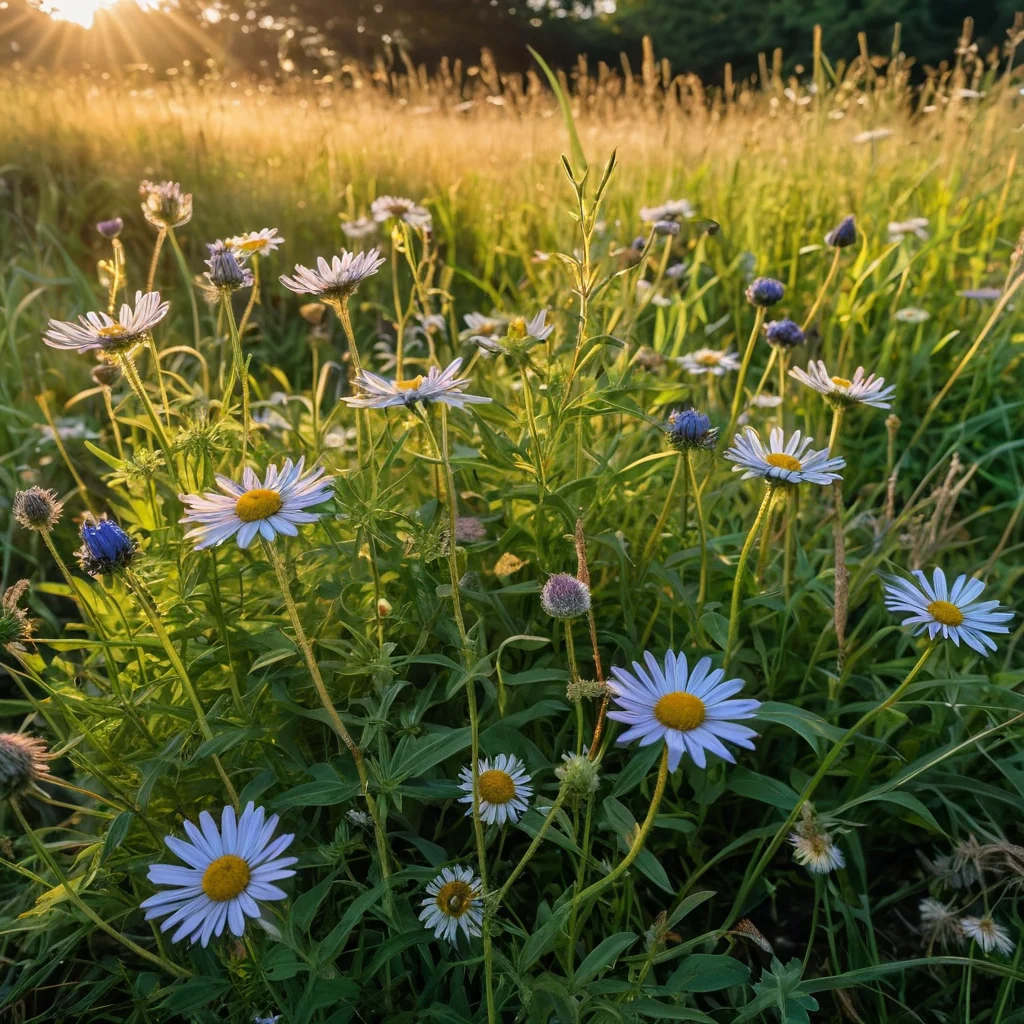
The heart of any lawn is its seeds. For a meadow variety, we need not just one or two types of grasses, but a whole orchestra of plants that will coexist harmoniously and create a unique picture. I always advise approaching seed selection consciously, considering the specifics of your plot and the desired outcome. Ready-made mixes are, of course, convenient, but sometimes you want to assemble your own unique “bouquet.”.
Main components of a meadow lawn:
- Cereal grasses: they form the base, providing green mass and density. It’s important to choose low-growing, unpretentious, and frost-resistant species.
- Legumes: for example, clover (white, creeping, red), alfalfa. They enrich the soil with nitrogen, improving its fertility, and give the lawn a special tenderness. White clover tolerates trampling well and recovers quickly.
- Wildflowers: it is they that give the meadow lawn its unique charm. They are chosen based on climatic conditions, soil type, and personal preferences.
What cereal grasses should be considered?
- Red Fescue (Festuca rubra): one of the best options. Forms a dense but soft turf, resistant to drought and shade, overwinters well. There are many varieties; choose those suitable for your region.
- Creeping Bentgrass (Agrostis stolonifera): forms a very dense, low turf, tolerates mowing well. However, it can be demanding of moisture.
- Various types of bluegrass (Poa): for example, Kentucky bluegrass (Poa pratensis). It is frost-resistant, durable, but develops quite slowly.
- Timothy-grass (Phleum pratense): a taller grass that gives the lawn a “meadow” character. Grows well on moist soils.
Popular wildflowers for a meadow lawn:
- German Chamomile (Matricaria chamomilla) and Oxeye Daisy (Leucanthemum vulgare): classics of the meadow style, giving the lawn a sunny mood.
- Cornflower (Centaurea cyanus): a bright accent, looks great in combination with other flowers.
- Common Poppy (Papaver rhoeas): scarlet, delicate, very striking.
- Bellflowers (Campanula): add sophistication and variety of forms.
- Yarrow (Achillea millefolium): drought-resistant, has beautiful umbrella-shaped inflorescences.
- Lupine (Lupinus): adds vertical accents and color variety.
- St. John’s Wort (Hypericum): unpretentious, blooms with bright yellow flowers.
Tips for choosing and mixing:
- Buy seeds in specialized stores: pay attention to the expiration date and the manufacturer’s reputation.
- Read the mix composition: if you are buying a ready-made mix, make sure it is suitable for a meadow lawn and contains diverse components.
- Consider the climate: choose plants that tolerate the specifics of your region well (frosts, drought).
- Soil type: some grasses prefer moister soils, others drier ones.
- Proportions: as a rule, cereal grasses make up 70-80% of the mix, legumes – 10-15%, flowers – 5-10%. The exact proportions depend on the desired effect.
- Don’t be afraid to experiment: start with a small area to see how the plants behave.
I often mix cereals with white clover and add a few types of unpretentious flowers to them. Such a lawn turns out not only beautiful but also alive – a real magnet for butterflies and bees!
Preparing the Plot for a Meadow Lawn: Step by Step
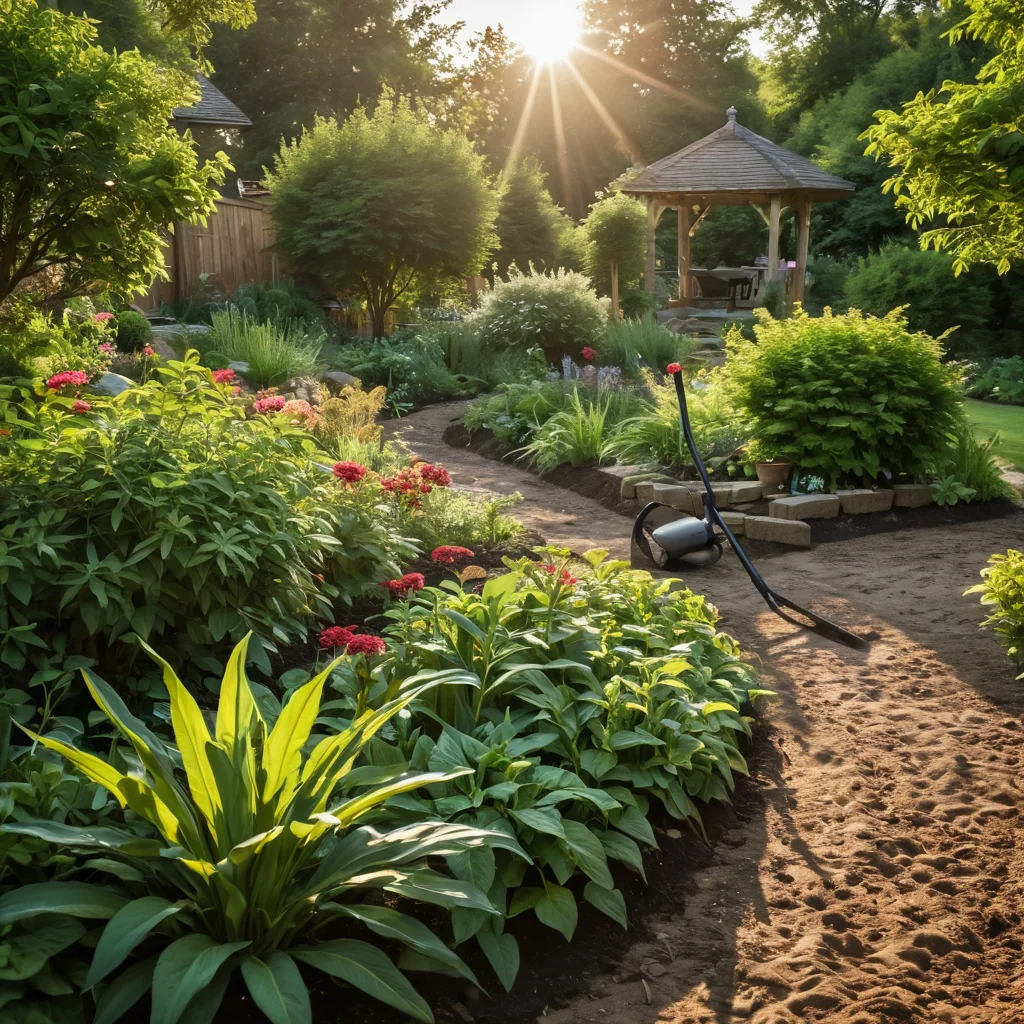
Even the most unpretentious meadow lawn requires proper plot preparation. This is a guarantee that your efforts will not be in vain, and the grasses and flowers will grow healthy and beautiful. This process is not complicated; the main thing is to follow the rules. Believe my experience, thorough preparation is already half the battle!
Step 1: Clearing the area
- Weed removal: this is the most important stage. Try to remove all perennial weeds with their roots. If the area is heavily overgrown, you can use a broad-spectrum herbicide (e.g., glyphosate-based), but it’s best to do this a few weeks before starting work so that the substance has time to decompose. I prefer the mechanical method – weeding, as I know for sure that I’m removing all weeds.
- Debris removal: stones, tree roots, construction debris – all this must be removed.
Step 2: Planning and leveling
- Determining the relief: a meadow lawn looks great on natural terrain, so there’s no need to level it “by the ruler.” However, obvious pits and humps where water might stagnate or, conversely, the soil will dry out should be eliminated.
- Light compaction: after leveling, you can lightly walk over the area with a garden roller or just with your feet so that the soil settles a bit.
Step 3: Soil improvement
- Fertilizer application: meadow grasses are not as demanding as lawn mixes, but they also need a nutritious environment. If the soil is poor, I advise applying organic fertilizers: humus, compost. They are evenly distributed over the surface and lightly incorporated into the topsoil (to a depth of 5-7 cm).
- Soil acidity: most meadow plants prefer neutral or slightly acidic soil. If you have acidic soil, you can add dolomite flour or lime. Acidity can be checked with litmus paper or special devices.
Step 4: Final preparation
- Digging or loosening: if you have applied fertilizers, they need to be incorporated into the soil. Deep digging is not necessary; loosening to the depth of a spade or with a rake is sufficient.
- Leveling with a rake: finally level the surface with a rake, breaking up soil clumps.
- Refraining from rolling (for meadow lawn): unlike a traditional lawn, a meadow lawn does not require perfect compaction. Slight looseness is even beneficial for seed germination.
What to remember:
- Don’t rush: let the soil settle after all the work. If you treated the area with herbicide, wait at least 2-3 weeks.
- Consider drainage: if your plot has areas where water constantly accumulates, you might need to think about drainage.
- Watering before sowing: a day or two before sowing, thoroughly moisten the prepared soil.
Properly prepared soil is like a good foundation for a house. It will ensure even seed germination, good root establishment, and subsequent healthy development of the plants. By following these simple steps, you will lay the foundation for a future blooming meadow at your dacha.
Sowing Seeds: How to Achieve Even Germination of a Meadow Lawn
The most exciting moment has arrived – sowing seeds! This is where the future of your meadow lawn is laid. To ensure friendly and even germination, and for the future lawn to be pleasing to the eye, you need to approach this stage with special care. I always try to sow in calm, windless weather so that the seeds don’t scatter.
Best time for sowing:
- Spring (April-May): when the soil has warmed up but still retains sufficient moisture.
- Late summer – early autumn (August-September): during this time, there is no scorching heat, and plants have time to establish themselves before the frost.
Preparation for sowing:
- Mixing seeds: if you are using a ready-made mix or creating your own, it is very important to thoroughly mix the seeds. This will ensure even distribution of different components across the entire plot. I often mix seeds with dry sand (in a 1:5 or 1:10 ratio) – this helps to better see where seeds have already fallen and prevents them from clumping.
- Dividing the plot: for large plots, it is more convenient to divide the area into several squares and sow each square separately.
Sowing methods:
- Manual sowing:
- Broadcasting: Take a small amount of the prepared mixture in your hand and evenly scatter it over the surface of the plot. Then repeat, moving in a different direction (e.g., first lengthwise, then crosswise). This helps to achieve more even coverage.
- Sowing with a seeder: There are manual or mechanical seeders that ensure more even seed distribution.
- Sowing for different components: If you are using seeds of very different sizes (e.g., small flowers and large cereals), it might be worth sowing them separately or taking this into account when mixing. Small seeds are often sown superficially, large ones are slightly buried.
Sowing rate:
- The sowing rate is usually indicated on the seed packaging. For a meadow lawn, it can range from 20 to 40 grams per square meter. It’s important not to overdo it – too dense sowing will lead to competition between plants and their weakening.
Final steps:
- Lightly covering the seeds: For a meadow lawn, deep covering is not required. The seeds can be lightly sprinkled with a thin layer (0.5-1 cm) of fertile soil or compost, or simply raked over so they are under a light layer of soil. Large cereal seeds can be lightly pressed into the soil with a roller.
- Watering: Very carefully, with a fine spray, water the sown area. It’s important not to wash away the seeds. The soil should be constantly moist during germination.
- Rolling (optional): After sowing and lightly covering the seeds, you can roll the area again to ensure good contact between the seeds and the soil.
What to do after sowing?
- Regular watering: keep the soil moist, especially in the first 3-4 weeks until the plants are established.
- Protection from birds: sometimes birds can peck at fresh seedlings. You can use special nets or scarecrows if the problem is serious.
- First mowing: when the grasses grow to 8-10 cm, perform the first mowing, removing no more than 1/3 of the height. This stimulates tillering.
By following these simple rules, you will give your future meadow lawn a great start. Patience and care are your main helpers at this stage.
Caring for a Meadow Lawn: Watering, Mowing, and Fertilizing
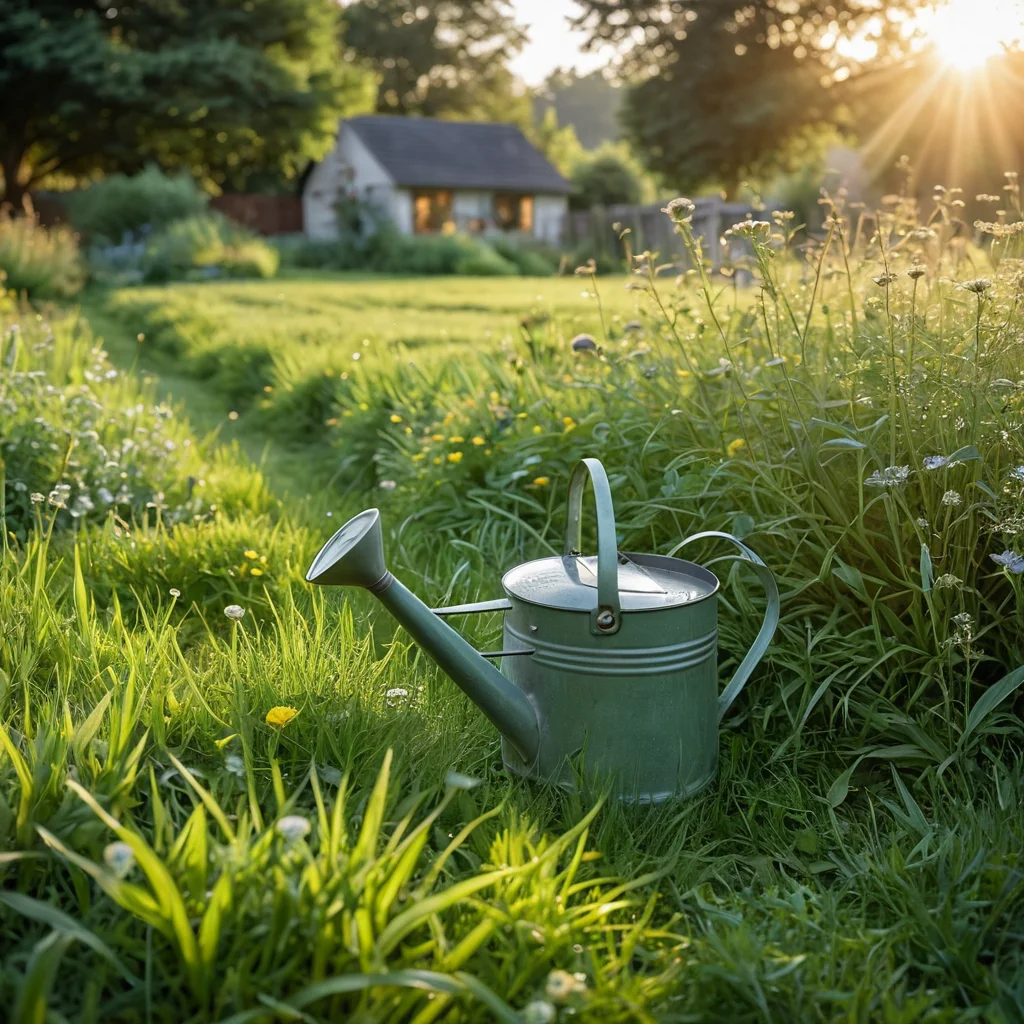
The main advantage of a meadow lawn is its minimal care requirements. If a traditional lawn is like a capricious primrose requiring constant attention, a meadow lawn is more like a hardy wildflower that knows how to live on its own. However, even it needs some care to remain beautiful and healthy.
Watering:
- During germination: The first 3-4 weeks after sowing are the most critical period. The soil should be consistently moderately moist. Water gently with a fine spray to avoid washing away seeds and young seedlings.
- Mature lawn: Subsequently, a meadow lawn becomes quite drought-tolerant. It only needs regular watering during the hottest and driest periods. Often, natural rainfall is sufficient. Overwatering is worse for it than slight drought. If you see that the grass is starting to dry out and lose its vibrancy, then it’s time to water.
Mowing:
- This is perhaps the most “difficult” element of meadow lawn care. The frequency and height of mowing depend on the effect you want to achieve.
- Minimal mowing: To preserve the “meadow” look and allow flowers to bloom, mow the lawn 1-2 times per season. This is usually done in late spring or mid-summer when the grasses become too tall. Set the mowing height quite high – 8-12 cm. Some of the clippings can be left in place – they will serve as natural fertilizer.
- Maintaining neatness: If you want the lawn to look more manicured but still retain its naturalness, you can mow it slightly more often (e.g., once a month), but also at a high height.
- Weed control: Infrequent mowing helps to control annual weeds – they don’t have time to form seeds. If aggressive perennial weeds (couch grass, sow thistle) appear, it’s best to remove them manually.
Fertilizing:
- A meadow lawn, unlike a traditional one, does not need frequent application of mineral fertilizers. If you applied compost or humus when preparing the soil, this is often enough for several years.
- Role of legumes: If your lawn contains clover or alfalfa, they will enrich the soil with nitrogen themselves, reducing the need for nitrogen fertilization.
- When to fertilize: If you notice that the grasses have become pale and the flowers are losing their vibrancy, you can fertilize with organic fertilizers (compost, biohumus) once a year – in spring.
- Avoid excess nitrogen: Strong nitrogen fertilization can lead to excessive growth of cereal grasses, which will start to crowd out flowers and legumes.
Other points:
- Pest control (moles, etc.): A meadow lawn, like any other, can be affected by moles. Repellents, ultrasonic deterrents, or folk remedies can help here.
- Aeration: If the soil on your plot is dense, you can aerate it (prick the turf with a fork) once every 1-2 years to ensure air circulation to the roots.
Remember that a meadow lawn is primarily about naturalness. Don’t strive for perfection, but enjoy its ever-changing, living beauty. The less you disturb it, the better it feels.
Common Mistakes When Creating and Caring for a Meadow Lawn
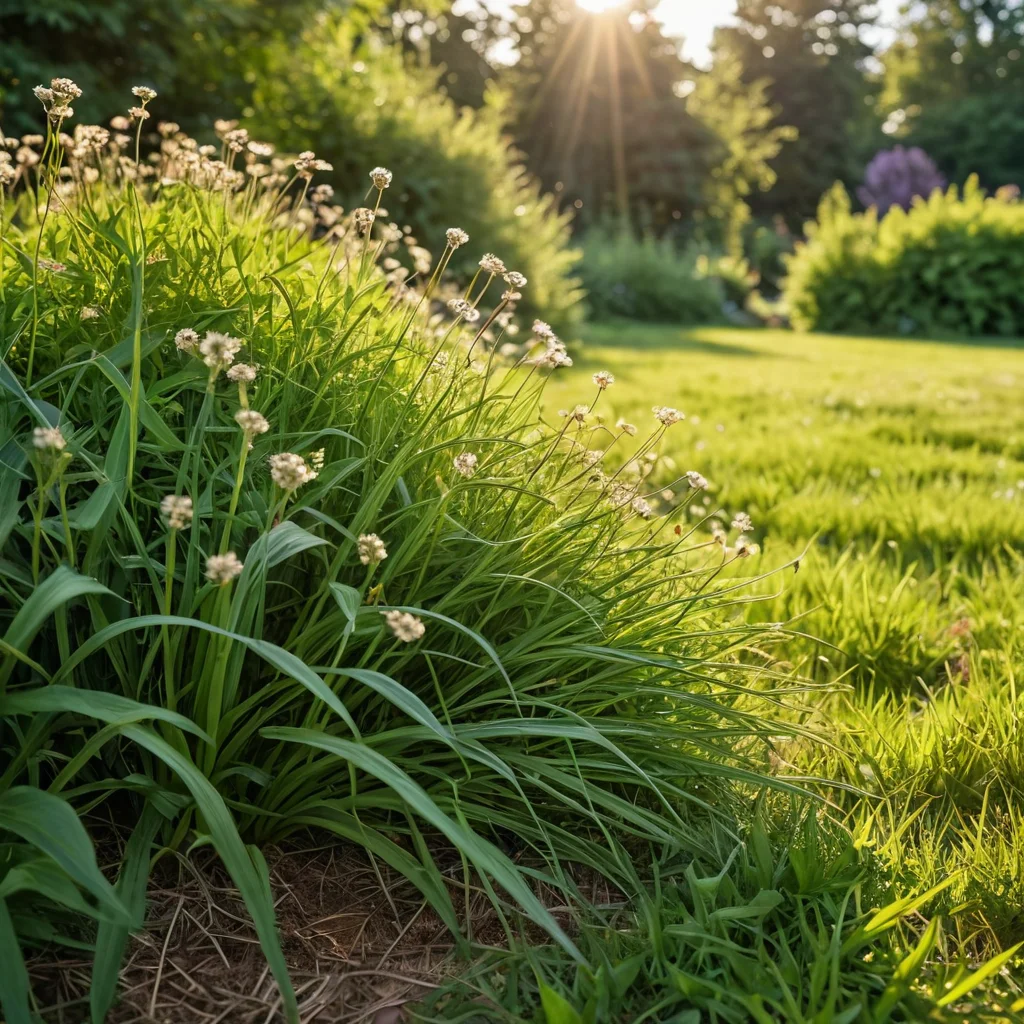
Even in such an unpretentious endeavor as creating a meadow lawn, mistakes can be made. The good news is that most of them are easily corrected, and some are not critical at all. But it’s better to know about them in advance to avoid unnecessary trouble. I’ve compiled the most common “pitfalls” that dacha owners encounter.
Mistakes during plot preparation:
- Insufficient weed removal: This is perhaps the biggest mistake. If perennial weeds with a strong root system are left, they will actively compete with young grass and flower seedlings, and your lawn may turn out sparse and patchy not from flowers, but from weeds.
- Using “heavy” soil: If you have clay, poorly draining soil, seeds can sour, and plant roots can rot. You might want to add sand or compost to improve the structure.
- Excessive leveling and compaction: Unlike a traditional lawn, a meadow lawn doesn’t need perfect smoothness. Overly dense, compacted soil hinders seed germination and plant rooting.
Mistakes during sowing:
- Uneven sowing: Too dense sowing leads to competition and weak plants. Too sparse sowing leads to bare patches, which will quickly be occupied by weeds.
- Poor seed mixing: If seeds of different species are unevenly distributed, some areas of the lawn may be denser, others sparser, or some plant species will dominate.
- Deep seed covering: Small flower and grass seeds need light to germinate. Burying them 1-2 cm deep can significantly reduce germination.
- Sowing in dry soil: Without sufficient moisture, seeds simply won’t germinate.
- Sowing in windy weather: Seeds will simply be blown across the entire plot, and germination will be uneven.
Care mistakes:
- Excessive mowing: Mowing at a low height kills the very idea of a meadow lawn. You simply get a weaker version of a traditional lawn, without flowers and with less biodiversity.
- Too frequent mowing: By not letting the grasses and flowers grow, you deprive them of the opportunity to bloom and reproduce.
- Excessive nitrogen fertilizers: Nitrogen stimulates green growth but can suppress flowering and make the lawn more susceptible to diseases.
- Ignoring weeds: Although a meadow lawn is self-sufficient, letting particularly aggressive weeds take over can lead to their dominance.
- Overwatering: Stagnant water is the enemy of a meadow lawn. It can lead to the development of fungal diseases and plant death.
How to fix mistakes:
- Weeding: Regularly remove weeds, especially in the first few years.
- Reseeding: If bare patches appear, reseed them with a mix of grasses and flowers.
- Adjusting mowing: Set a high mowing height and reduce mowing frequency.
- Avoid chemicals: Use organic fertilizers and manual weeding as much as possible.
The main principle of a meadow lawn is naturalness and minimal intervention. Don’t worry if it doesn’t look perfectly “groomed.” Its beauty is in its uniqueness, in its life!
Meadow Lawn as an Element of Landscape Design: Ideas and Inspiration
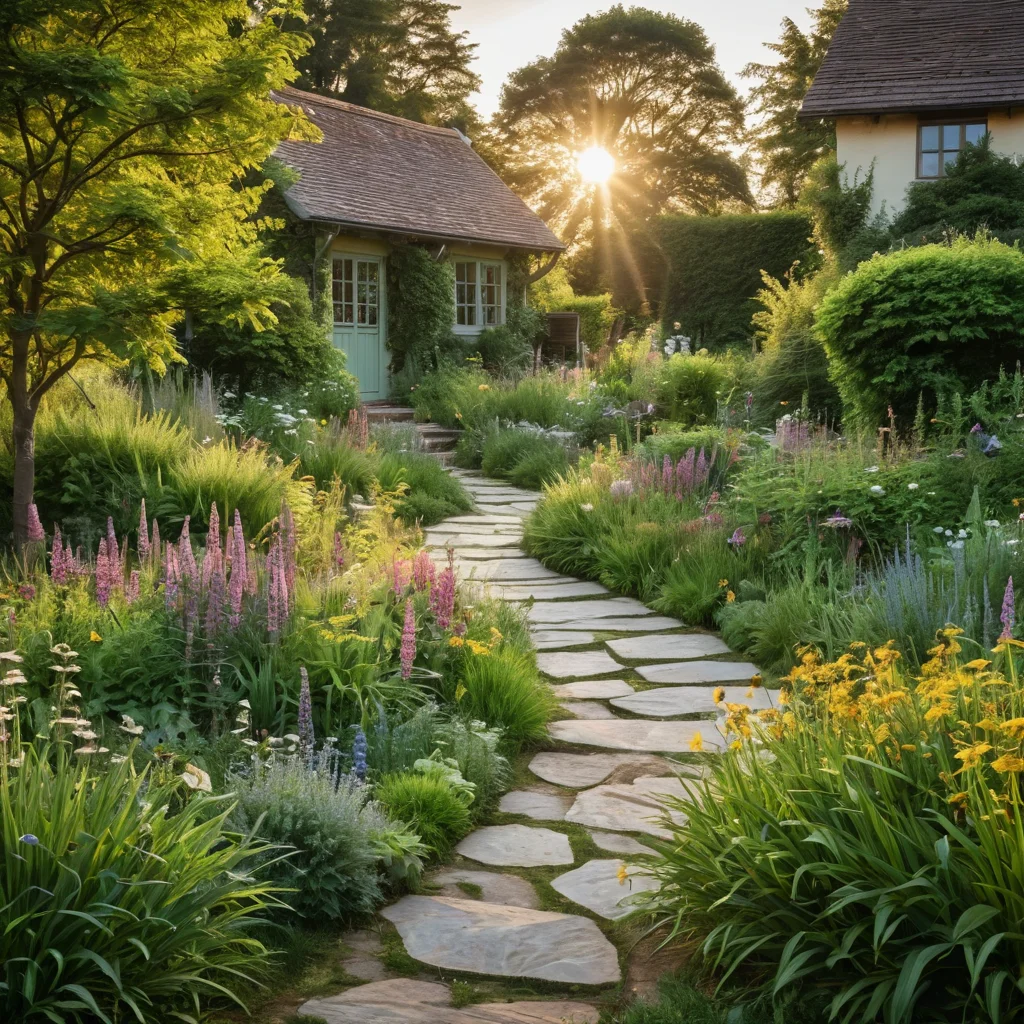
A meadow lawn is not just a green cover; it’s a real landscape design tool capable of transforming your plot beyond recognition. It brings notes of natural wildness, romance, and tranquility to the garden. If you want to create a truly magical space, here are some ideas on how to integrate a meadow lawn into your design:
1. Creating “wild” corners:
- Rest area: Create a meadow lawn in the far corner of the garden where you can place a bench or a small table. It will be your personal “island” of peace, where you can enjoy the singing of birds and the fragrance of flowers.
- Transition between zones: Use a meadow lawn for a smooth transition from more formal garden areas (e.g., patio, terrace) to more natural ones – for example, to a decorative pond or rock garden.
2. Combining with other elements:
- Stone paths: A meadow lawn looks great along the sides of winding garden paths laid with natural stone or gravel. The grass, gently bordering the stones, creates the impression of a natural, overgrown path.
- Trees and shrubs: Place a meadow lawn around the trunks of old trees or under spreading shrubs. This will create the effect of a forest clearing and emphasize the natural beauty of the plants.
- Flower beds: A meadow lawn can serve as a beautiful backdrop for bright flower beds. Combinations with tall flowers or ornamental grasses look particularly effective.
3. Creating an “edible” meadow:
- Aromatic herbs: Plant oregano, lemon balm, mint, thyme among the meadow grasses. This will not only decorate your lawn but also provide an opportunity to gather fresh herbs for tea or cooking.
- Berries: Small patches of wild strawberries or garden strawberries integrated into the meadow lawn will add practicality and charm.
4. Creating “living” cover for slopes:
- A meadow lawn is an ideal solution for strengthening and decorating slopes. It is less prone to erosion than a traditional lawn and looks much more picturesque.
5. Imitating natural landscapes:
- “Mexican” lawn: Use grasses with reddish or brownish hues, add bright, exotic flowers.
- “Alpine” meadow: Choose low-growing grasses and flowers that mimic alpine meadows.
Practical design tips:
- Shape: Don’t be afraid to use irregular, flowing shapes for meadow lawns. They look more natural.
- Contrast: Combine a meadow lawn with more structured garden elements – hedges, geometric flower beds, wooden decks.
- Seasonality: Remember that a meadow lawn changes throughout the year. In spring, it is delicate and green; in summer, it is colorful with flowers; in autumn, it takes on golden hues. Plan the design considering these changes.
A meadow lawn is your chance to bring a piece of wild nature into your garden, to create a cozy and romantic space that will change with the seasons. It’s an opportunity for creativity, where you act as both a gardener and an artist. Enjoy the process of creating your unique natural corner!
